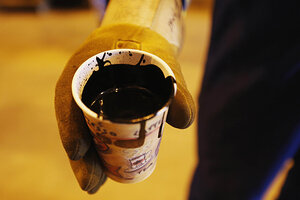Utah OKs first US oil sands project
After years of working to obtain permission from the state, Alberta-based U.S. Oil Sands Inc. was given the final go-ahead Wednesday to develop the first commercial oil sands project in the US.

A worker holds a cup of crude oil to be tested at the Cenovus Foster Creek SAGD oil sands operations near Cold Lake, Alberta, in this July 2012 file photo. Utah's Water Quality Board cast a final vote Wednesday to approve what will be the first commercial oil sands project in the US, barring a legal challenge.
Todd Korol/Reuters/File
The Utah water board has voted to approve the United States' first commercial oil sands project.
Alberta-based U.S. Oil Sands Inc.expects its new plant will produce an output of 2,000 barrels of petroleum product a day from oil sands by 2013.
Environmental groups say they're likely to appeal Wednesday's decision by the Utah's Water Quality Board, which paved the way for the new plant.
The legal battle over the oil sands has been overshadowed during the past year by the proposed US pipeline from Canadian oil sands. U.S. Oil Sands Inc. has been working since 2005 to obtain permission from the state to develop oil sands in Utah's Book Cliffs.
The Utah Water Quality Board's 9-2 vote upheld a regulator's previous ruling that the project would pose no threat of groundwater pollution. The 213 acres of arid land encompassing the site contains no significant groundwater, according to the state.
The approval comes despite legal challenges from environmental groups. Living Rivers, a Moab, Utah-based ecological restoration group, says that a solvent used in the project could be carcinogenic when mixed with bitumen from the oil sands. While the desert area may not contain groundwater, Living Rivers contends that snowmelt and rain can occasionally saturate the project site.
“It’s really hard to visualize how giant this threat could be," Joro Walker, an attorney for Western Resource Advocates, the organization representing Living Rivers, told the Salt Lake City Weekly. "I don’t think people in Utah are really paying attention."
Representatives from U.S. Oil Sands Inc. dismiss these concerns, saying that the solvent used in production is citric-based and poses no threat to the environment.
"Using a unique bio-solvent the Company is able to separate bitumen from oil sand without the need for tailings ponds," the U.S. Oil Sands' web site reads. "The process requires low energy input, recycles 95% of the water used and uses best practice mining methods to rapidly reclaim mined areas."

